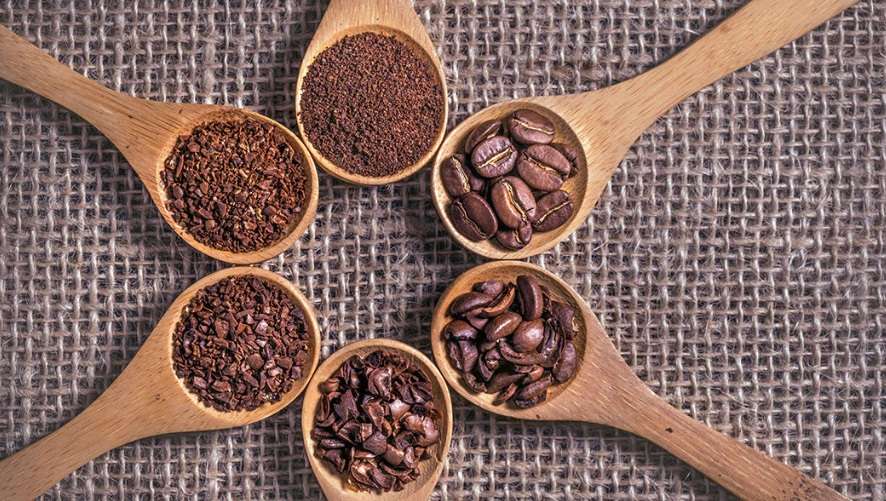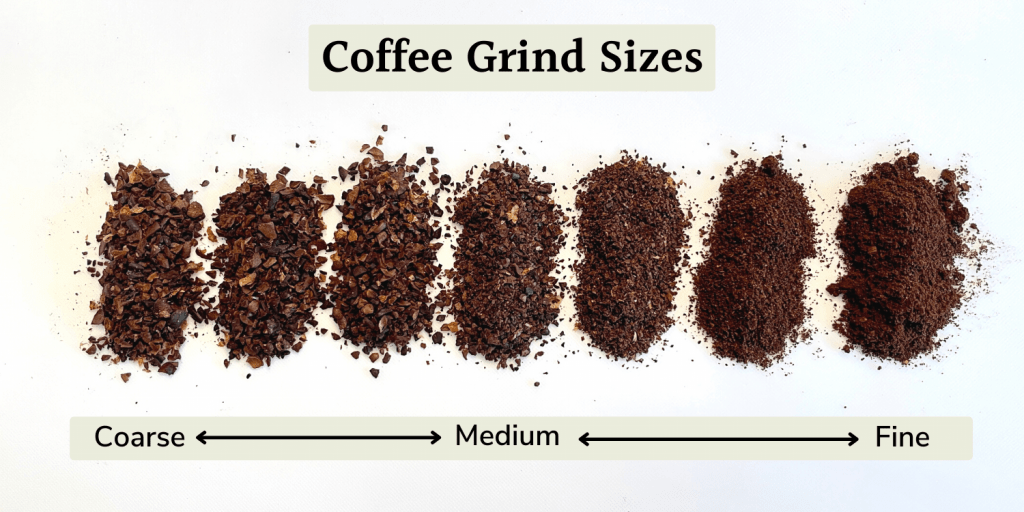
Grind size plays a pivotal role in coffee brewing, acting as a key to unlocking the flavor complexities of your coffee beans. It’s not just about grinding beans down to a powdery form; it’s about precision and understanding how the size of the grind affects the brewing process.
Fine grind coffee, with its texture akin to table salt or powdered sugar, is particularly significant for those who cherish a rich, full-flavored cup. This grind size is the hallmark of espresso, a method that extracts the essence of coffee under high pressure, delivering a concentrated and vibrant brew in a short amount of time. Similarly, the Moka pot and AeroPress have adapted to leverage fine grind’s quick extraction capabilities, ensuring that every sip is laden with the coffee’s intrinsic flavors.
Key Takeaways
- Ideal for Espresso and More: The fine grind is synonymous with espresso, Moka pot, and AeroPress brewing methods. These methods are celebrated for their ability to produce a coffee that is intense and flavor-packed, owing much to the fine grind’s rapid extraction rate.
- Consistency Matters: Achieving the right consistency, similar to table salt or powdered sugar, is crucial. This consistency is not just for aesthetics but for ensuring the coffee water interaction is optimized for these specific brewing techniques.
- Quick Extraction, Rich Flavor: The fine grind size facilitates a swift extraction process. This quick interaction between water and coffee grounds extracts a spectrum of flavors, from bold and robust to subtle and sophisticated, in a remarkably short time.
- Precision in Brewing: To fully harness the potential of fine grind coffee, precision in brewing method and equipment is non-negotiable. The right pressure, temperature, and timing are essential to yield a cup that’s both memorable and satisfying.

Understanding Coffee Grinds
When it comes to brewing a great cup of coffee, the size of your grind matters more than you might think. It’s the first step in a journey that takes those beans from their solid state into a flavorful brew. Here’s why: the grind size affects how water interacts with coffee grounds during brewing, determining the extraction rate of flavors. A finer grind increases the surface area exposed to water, speeding up extraction but also risking over-extraction, which can lead to bitterness. On the other hand, a coarser grind slows down this process, making it ideal for brewing methods where coffee grounds steep for longer.
Now, let’s talk about grinders. Blade and burr grinders play a crucial role in achieving the right grind consistency. Blade grinders, often more affordable, use a spinning blade to chop beans, resulting in a less uniform grind. This inconsistency can lead to uneven extraction, where some coffee particles are over-extracted, and others under-extracted, affecting the overall taste.
Burr grinders, however, are the choice of coffee aficionados. They crush beans between two burrs to a uniform size, providing a consistent grind that’s crucial for extracting the perfect flavor from your beans. This uniformity allows for a more balanced extraction, giving you a smoother, more enjoyable cup of coffee.
Grind Sizes Explained
Extra Coarse to Coarse Grind
Think of the texture of chunky sea salt when you consider extra coarse to coarse grinds. These larger, bolder granules are your best bet for brewing methods like cold brew and French press. Why? Because these methods allow coffee grounds to steep for extended periods, letting the water slowly extract flavors without passing through the grounds too quickly. The result? A smooth, bold cup that’s never bitter.
Medium-Coarse Grind
Moving slightly finer, the medium-coarse grind feels like rough sand. It’s the go-to for Chemex and Clever dripper enthusiasts. This grind size strikes a balance, allowing for a moderate extraction rate that suits the medium filter papers and immersion brewing techniques. It’s coarse enough to prevent over-extraction yet fine enough to extract the right amount of flavor, giving you a clean and bright cup.
Medium Grind
The medium grind is akin to regular beach sand. It’s versatile, fitting perfectly with drip coffee makers and flat-bottom pour overs. This grind size allows for a balanced extraction, where the water isn’t rushing through too quickly but isn’t lingering too long either. It’s the middle ground (pun intended) for those seeking a harmonious blend of flavors in their daily cup.
Medium-Fine Grind
Slightly finer than medium, the medium-fine grind has a texture similar to granulated sugar. It’s excellent for cone-shaped pour overs and the AeroPress, especially when you’re aiming for a brew time on the quicker side. This grind size ups the resistance against water just enough to enhance flavor extraction without tipping into bitterness, making for a rich and complex cup.
Fine Grind
The fine grind is where precision brewing hits its stride. With a consistency that mirrors table salt, it’s ideal for espresso machines and AeroPress recipes with short brew times. At this grind size, water passes through quickly under pressure, extracting a concentrated burst of flavor and aroma. This is where the coffee’s essence shines, delivering a potent, flavor-packed experience that stands as the essence of coffee craftsmanship.
Choosing the Right Grind for Brewing Methods
When it comes to making your favorite coffee, selecting the right grind size for your brewing method can make all the difference. Let’s break down which grind sizes match perfectly with some of the most beloved brewing methods:
- French Press: For this classic brew method, a coarse grind resembling chunky sea salt is your best choice. The large grind size allows for a slow and even extraction, which is essential since the coffee grounds steep directly in hot water.
- Pour-Over: Pour-over enthusiasts will find a medium to medium-fine grind ideal, akin to granulated sugar or fine sand. This grind size allows for a balanced extraction as water flows through the coffee grounds and filter, capturing a full range of flavors.
- Espresso: The quintessential espresso requires a fine grind, similar to table salt. This fine grind is crucial for creating the resistance necessary for pressurized water to extract the coffee’s intense flavors and aromas within the short brew time of an espresso shot.
- AeroPress: The AeroPress is versatile, accommodating a range of grind sizes from medium to fine, depending on your brewing time and desired flavor strength. A finer grind works well for shorter brew times, producing a rich and full-bodied cup.
Advanced Tips for Coffee Grinding
Getting your grind right is just the beginning. Here are some pro tips to elevate your coffee game:
- Accurately Measuring Beans: Consistency starts with measurement. Use a scale to measure your coffee beans before grinding. This ensures you’re using the exact amount needed for your brew, leading to a more consistent taste.
- Purging Automatic Grinders: If you’re using an automatic grinder, it’s wise to purge it after making adjustments to the grind size. This means running the grinder for a few seconds and discarding the grounds. This step ensures that your next grind will be consistent with your new settings.
- Dialing in Espresso: Espresso making is an art that involves adjusting the grind size to achieve the perfect shot. Start with the recommended settings and adjust finer or coarser as needed to hit your espresso machine’s ideal extraction time.
- Adjusting for Bean Age and Roast Profile: Keep in mind that the age of your beans and their roast profile can affect the ideal grind size. Fresher beans and darker roasts may require slight adjustments to the grind size for optimal flavor extraction.
FAQs
How do I achieve the perfect fine grind for my coffee?
Achieving the perfect fine grind starts with using a quality burr grinder, which provides uniformity and precision. Adjust the grinder to the fine setting, and do a few test grinds to ensure consistency. It should resemble table salt in texture.
What are the best grinders for fine coffee?
Burr grinders are the gold standard for achieving a fine grind. They offer consistent grind sizes, essential for espresso and AeroPress brewing methods. Look for grinders with multiple settings to fine-tune your grind.
How can I adjust the grind size for different brewing methods?
Most burr grinders come with adjustable settings, ranging from coarse to fine. Start with a medium grind for drip coffee, a coarse grind for French press, and a fine grind for espresso. Experiment and adjust one notch at a time until you find the perfect setting for your taste.
Final Thoughts
Selecting the right grind size is more than a step in the coffee brewing process; it’s a pivotal decision that shapes the flavor and quality of your cup. Fine grind coffee, ideal for espresso and AeroPress, requires precision to unlock the beans’ full potential. But, no matter the brewing method, matching the grind size to it ensures that every cup is a testament to the coffee’s natural excellence. Embrace the art of grinding, and elevate your coffee experience to new heights.









